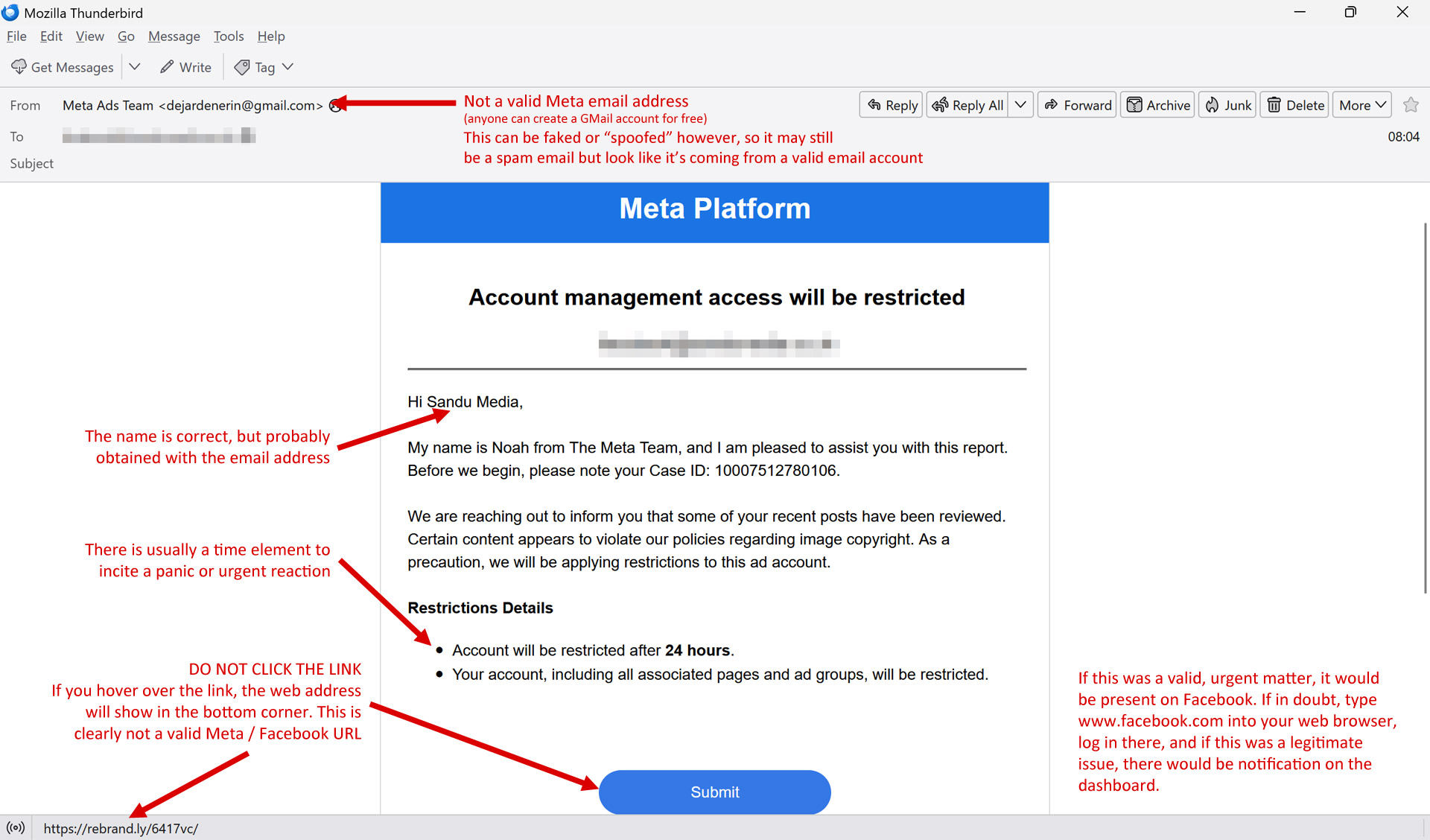Sandu Media > Articles
Email Safety Tips
Dealing with spam emails can be a constant battle, but there are several effective strategies you can employ to minimize their presence in your inbox. Here's a comprehensive guide:
Prevention is Better Than Cure
Avoid posting your primary email address publicly on websites, forums, or social media. Spam bots can pick this up from websites and add it to their lists. If you want have a contact email address on your website we can obfuscate your email address so it can't be picked up by a bot, but can still be readable by a human user. Having said that, we would still recommend having a contact form rather than displaying an email address, as this can be managed easier and spam messages can be filtered out.
Before providing your email address to any website or service, carefully review their privacy policy to understand how they will use your information. Be cautious of pre-selected options that automatically subscribe you to mailing lists. Uncheck those boxes if you don't want to receive promotional emails. Sometimes even with all that in mind your email address can be passed on to third parties, so be careful when signing up for certain services.
How to Spot a Scam Email
Spam emails are mostly just an annoyance, but scam emails can much more serious. "Phishing" is a malicious technique used to obtain your sensitive data such as your username and password. This is often done by email. The method involves sending you a convincing looking email pretending to be from a service you use (such as a bank, email provider, eBay etc.). Typically this will contain a negative (sometimes time-critical) message along the lines of "you will be locked out your account", or "your email account is out of storage", or something similar. They will then provide a link to "fix" the problem. The link they provide will be a fake mockup of the service you use. Instead of logging in all you will be doing is sending your username and password to them, which they can then use to take over your account.
Unfortunately, the email they send can look very real, and they can even fake the "from" email address so it looks legitimate. One of the first things to check is the senders email address. If the domain name (web address) doesn't match your service, it's certainly a scam. However, as mentioned, the sender's address can be faked. Never click on a link from a suspicious email, but you
can hover over the link to see the destination. This will almost certainly be a different web address from the one your service uses. However, even this can sometimes be close enough to the original to overlook. If the email includes a line like "you have 24 hours before your account is deactivated" it can be easy to miss the difference.
If you do suspect a scam email, never click on the link. Instead log in to the service by typing the website address into your web browser and logging in there. If there
is anything you need to take action on it will almost certainly a notification on the website the moment you log in to your account.
 An example of a scam email. Click to expand.
An example of a scam email. Click to expand.
Email Tools
Ensure your email provider's spam filter is enabled. If you have emails hosted with us we have this set by default. It is worth regularly checking your spam or junk folder to ensure legitimate emails haven't been mistakenly filtered. If they have, you will be able to mark the sender' email address as safe, or add them to your "whitelist" so that their emails always come in to your inbox and don't end up in the spam folder.
Use the "Report Spam" or "Mark as Junk" feature to help your email provider's filter learn to identify and block similar emails. You can also block specific email addresses or domains that consistently send spam. If you are receiving spam from your website's contact form do not block the senders address as this will stop all messages from your website. Instead, set up a rule to block certain words, email addresses, or IP addresses via your contact form administrator.
Practice Safe Email Habits
- Never click on links in emails from unknown or untrusted senders. If in doubt, type the business web address into your browser and log in there.
- Be wary of emails that request personal information, passwords, or financial details.
- Avoid opening email attachments from senders you don't recognize, as they may contain malware.
- Use the "unsubscribe" link provided in legitimate marketing emails, but be cautious of suspicious emails that may use fake unsubscribe links to confirm your email address.
- Disabling automatic image downloading in your email client can prevent spammers from tracking whether you've opened their emails.
- Don't Respond! Never reply to spam emails, as this confirms your email address is active.
By implementing these strategies, you can significantly reduce the amount of spam you receive and protect yourself from potential threats.


 An example of a scam email. Click to expand.
An example of a scam email. Click to expand.